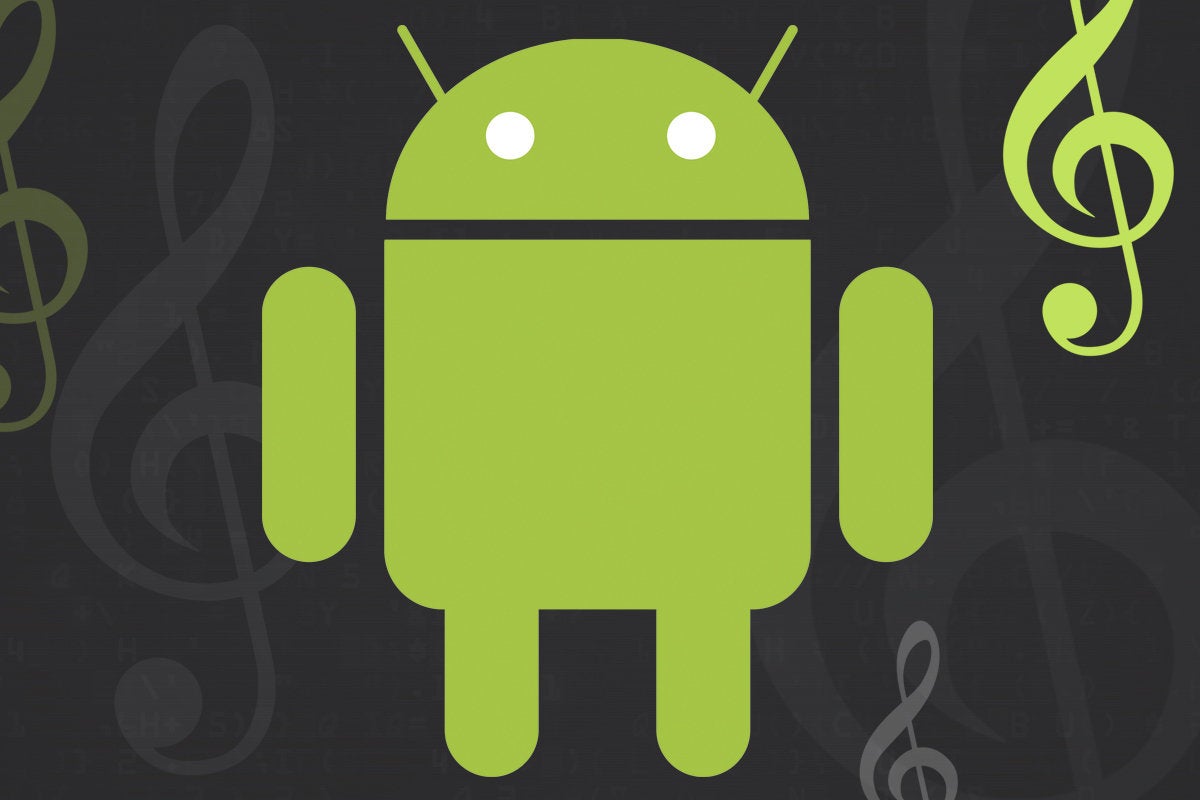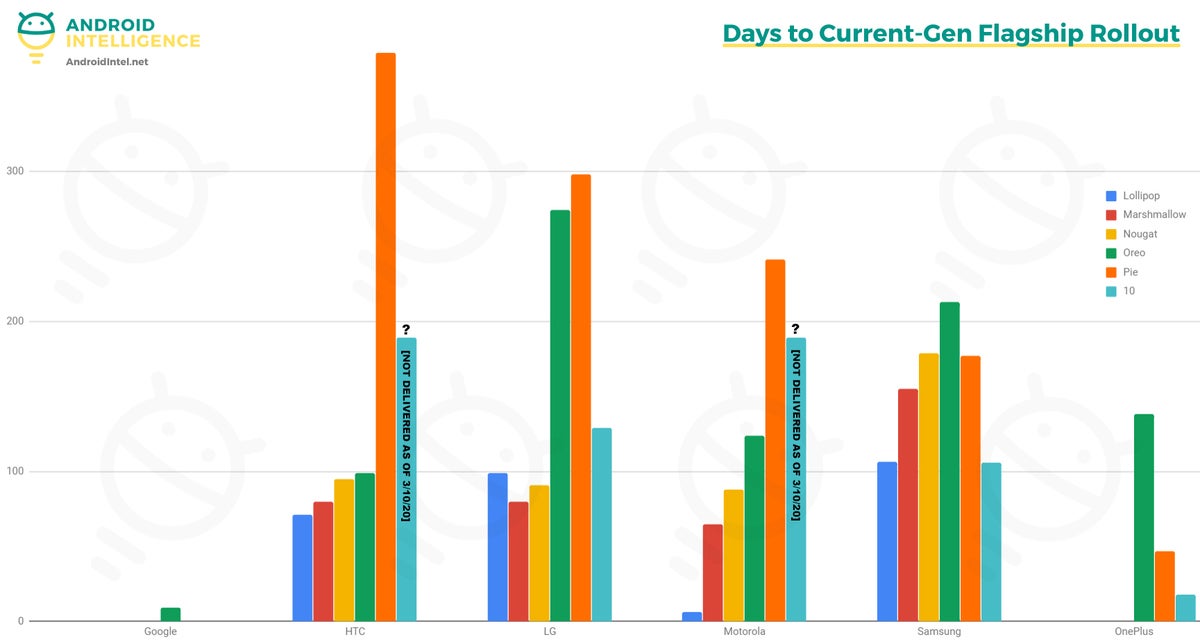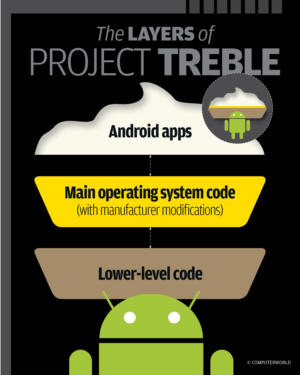

What is Project Treble? The Android upgrade fix explained | Computerworld
source link: https://www.computerworld.com/article/3306443/what-is-project-treble-android-upgrade-fix-explained.html
Go to the source link to view the article. You can view the picture content, updated content and better typesetting reading experience. If the link is broken, please click the button below to view the snapshot at that time.
What is Project Treble? The Android upgrade fix explained
Google's Project Treble promised to pave the way for faster Android upgrades — so what exactly is it? Two years in, how well is it working?

It's tough to talk about Project Treble without getting lost in a forest of technical gobbledygook.
And it's no wonder: Project Treble (take a deep breath) is Google's ambitious effort to rearchitect Android in order to establish a modular base in which the lower-level code created by silicon vendors is separated from the main Android operating system framework so that device manufacturers can update the OS code without having to rely on silicon vendors to refresh the lower-level code for every release.
Whew! See what I mean?
In reality, though, Project Treble doesn't have to be so complicated. Let's break down what Treble is actually all about, in real-world terms — and what it actually means for you, as someone who uses Android and doesn't necessarily speak the language of mumbo-jumbo.
[ Further reading: Are Android upgrades actually improving? It's complicated ]
We'll start at the beginning:
What is Project Treble — in plain English?
I just fed the technical explanation into my patented Geek-to-English Translation Machine, and here's what came out: Project Treble, at its core, is all about making it faster, easier, and cheaper for phone makers to process Android software updates and get them out to users.
That's the short version. Now, the context: In the past, every time a new Android version came along, phone makers had to wait for the chipset vendors — the companies like Qualcomm, which supply the processors and other pieces inside the devices — to update the areas of the code related to all of that internal hardware. It was only when that effort was finished that the phone-maker was able to start its part of the process: integrating the new Google-provided software with its own interface customizations and feature additions, then testing it all thoroughly and getting it ready to roll out.
What Treble does is separate that lower-level stuff — the areas of the code related to a phone's processor, modem, and so on — from the rest of the operating system. That way, those lower-level elements don't have to be updated every time a new Android version comes along; they just exist as a constant foundation beneath everything else, and that first part of the process is no longer required.
IDG / Computerworld
Project Treble separates the hardware-specific code (the pie crust) from the main Android OS code (the filling). Android apps are the delicious topping. (Click image to enlarge.)
To borrow an analogy from an earlier analysis, you can think of the whole thing like a pie: Up till recently, all of Android was mixed together, and that meant each ingredient had to be updated and stirred into the batter from scratch with every single OS update. Thanks to Treble, all the hardware-specific elements now exist as a crust — one that remains in place for a device's entire life. And so whenever a new Android release arrives, the phone maker can focus solely on its part of the process — the filling — without first having to wait for someone else to provide a freshly made foundation.
Google actually started this process with its Android 8.0 Oreo release, in 2017, by creating the initial boundary between the operating system and the lower-level code. Rather fittingly, however, 2018's Android 9 Pie software marked the first time the setup was complete and operational — with chipset vendors ready to support it and with a significant number of Treble-ready devices out in the wild and waiting.
Why is Project Treble even necessary?
Over the past several years, Android upgrades have devolved into a big, hot mess — and that's putting it mildly: Aside from Google itself, with its Pixel line of phones, no Android device maker provides consistently timely and reliable software updates. And it's the users who suffer, getting stuck with dated software that lacks not only features and interface improvements from newer releases but also privacy and security enhancements and a variety of other under-the-hood improvements that only OS updates can provide.
While Google has taken significant steps to make OS updates less all-important on Android — unbundling most system-level apps and services from the operating system so they can be updated regularly and universally, directly through the Play Store, and providing an increasing array of device options that come with timely update guarantees — it can't remove all of the importance from the core system software. And the vast majority of Android users remain on devices that receive OS updates painfully late, if ever.
And that's why Project Treble came about — to try to cut out some of the time and cost associated with processing OS updates so that manufacturers would step up their games and users could start getting current software more quickly.
How much difference is Project Treble actually making?
That's the million-dollar question — and with two years of Treble-aided updates now in front of us, the answer isn't especially uplifting.
According to my interview with one of Google's Treble architects, Treble should shave about three months off the typical upgrade process by eliminating that initial lower-level phase. But scrutinizing the data from device-makers' performance with both the Pie upgrade and the more recent Android 10 rollout, it's clear that hasn't exactly happened.
Let's start with Pie: As my February 2019 analysis of that rollout makes all too apparent, nearly every major Android flagship device-maker (from a U.S. perspective) saw little to no improvement with the first true Treble test. Some companies even did meaningfully worse with the initial post-Treble rollout than they did with earlier, non-Treble-affected Android releases.
Samsung, notably, did a touch better with Pie than it did with Oreo, the year before — but it's hard to frame its success as a Treble-related victory. The company went from 213 days between the software's release and its first U.S. flagship phone rollout with Oreo to 177 days with Pie. That's an improvement of 36 days, which is certainly something — but it isn't nearly enough to account for the estimated 90 days of work Treble was supposed to save.
Plus, looking back even further, Samsung took 179 days to deliver Nougat to its then-current flagship the previous cycle — basically the same amount of time it took with Pie. Before that, the company took 155 days with Marshmallow and 105 days with Lollipop. So all that really happened was that Samsung had an especially bad year with Oreo and then went back to its still-underwhelming Nougat-level performance a year later — without even going as far as to match its slightly less embarrassing Marshmallow- or Lollipop-era performances from the years before that.
One company actually did achieve the 90-day improvement window Treble was designed to provide: OnePlus, the relatively small-scale maker of phones that have long been popular within the Android enthusiast community and have just recently started to see some more mainstream success. That's a promising indication of the type of improvement Treble can theoretically enable — but the success is somewhat diminished by the fact that OnePlus simultaneously took 47 days longer to get Pie out to its previous-gen flagships than it did with Oreo the previous year (and in the case of OnePlus, those phones were indeed all Treble-ready).
So that's year one of living in a Treble-enhanced world, in a nutshell. In year two, with 2019's Android 10 update, some device-makers managed to improve their delivery times a bit further — but the results are rather scattered and still don't seem to point specifically to any Treble-connected success.
Samsung, for instance, got about a hundred days faster with both its current-gen and previous-gen flagship rollouts in the Android 10 cycle — certainly nothing to write off. But at the same time, that level of improvement actually just brought the company back (almost) to its 2014 performance, with Lollipop. So can we really credit a return to a six-year-old standard — one that wasn't even particularly impressive back then — to a change that came about in the last couple of years? It seems like a stretch.
LG also almost matched its 2014 level of mediocrity with the Android 10 rollout, on the current-gen flagship front, and is doing significantly worse than it did in 2014 with its previous-gen flagship phone support. (As of this writing, the company has yet to send Android 10 to its previous-gen flagship in the U.S. and is already two months and counting behind its 2014 standard.) HTC and Motorola, meanwhile, have yet to send Android 10 to any U.S. flagships, well over six months after the software's release.
Again, the one exception to the rule is OnePlus, which brought its current-gen flagship delivery down to a mere 18 days with Android 10 — compared to 47 days with Android 9 and 138 days with Android 8. OnePlus did better with its previous-gen flagship, too, with a 93-day delay for Android 10 delivery. That's still too long of a wait to be commendable, though, and it's also essentially just bouncing back from a bad year to match the company's previous-gen upgrade performance in 2017.
It took many Android manufacturers longer to roll out Pie to current-gen devices than it did to deploy Oreo, though some have improved with Android 10. (Click image to enlarge it or here to see a detailed analysis.)
" target="_blank" class="readableLinkWithLargeImage">

It took many Android manufacturers longer to roll out Pie to current-gen devices than it did to deploy Oreo, though some have improved with Android 10. (Click image to enlarge it or here to see a detailed analysis.)
All these numbers are a lot to process, but the main takeaway is that it's tough to square the data — even in areas where improvements are present — with any sort of narrative about Treble being the driver of the change.
More than anything, what we're seeing serves to highlight a stark reality of the Android upgrade situation: Regardless of what improvements are made to the technical part of the process, most manufacturers simply aren't motivated to make timely and reliable upgrades a priority. And why should they? Post-sales software support requires a fair amount of time and resources, even with Treble's adjustments in place, and all of that effort brings little tangible benefit to the typical third-party Android device maker.
In fact, one could argue that providing timely and reliable software enhancements actively works against most companies' interests, as it makes phone owners less likely to feel the need to spend money on a new device. Treble, unfortunately, can't address that part of the equation; if phone makers see no reason to take post-sales software support seriously, all the optimization in the world won't make an ounce of difference.
All considered, what we can say is that Treble absolutely does cut out a significant portion of the work required for phone makers to process and deliver OS updates — and that can and should make it possible for upgrades to be delivered faster without any additional investments. How things play out from there, however, is ultimately in each manufacturer's hands, as these first two years of evidence illustrate.
This article was originally published in September 2018 and most recently updated in April 2020.
Recommend
About Joyk
Aggregate valuable and interesting links.
Joyk means Joy of geeK
